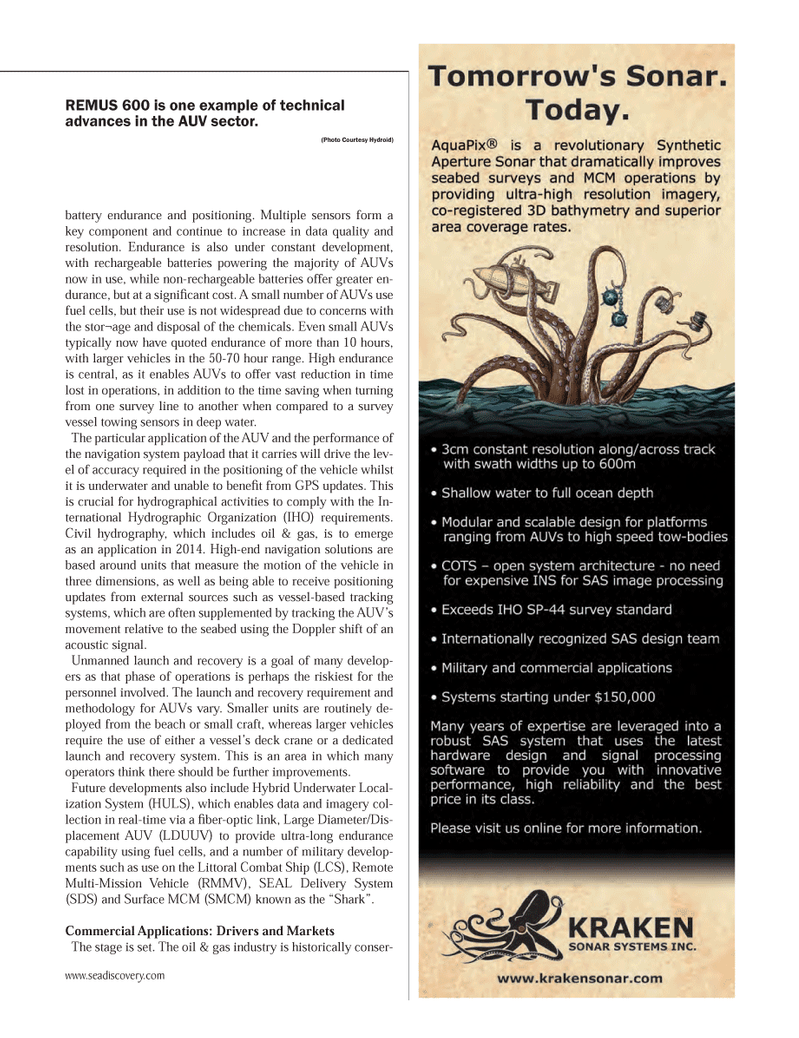
Page 25: of Marine Technology Magazine (May 2014)
AUV Operations
Read this page in Pdf, Flash or Html5 edition of May 2014 Marine Technology Magazine
battery endurance and positioning. Multiple sensors form a key component and continue to increase in data quality and resolution. Endurance is also under constant development, with rechargeable batteries powering the majority of AUVs now in use, while non-rechargeable batteries offer greater en- durance, but at a signiÞ cant cost. A small number of AUVs use fuel cells, but their use is not widespread due to concerns with the storÂage and disposal of the chemicals. Even small AUVs typically now have quoted endurance of more than 10 hours, with larger vehicles in the 50-70 hour range. High endurance is central, as it enables AUVs to offer vast reduction in time lost in operations, in addition to the time saving when turning from one survey line to another when compared to a survey vessel towing sensors in deep water. The particular application of the AUV and the performance of the navigation system payload that it carries will drive the lev- el of accuracy required in the positioning of the vehicle whilst it is underwater and unable to beneÞ t from GPS updates. This is crucial for hydrographical activities to comply with the In- ternational Hydrographic Organization (IHO) requirements. Civil hydrography, which includes oil & gas, is to emerge as an application in 2014. High-end navigation solutions are based around units that measure the motion of the vehicle in three dimensions, as well as being able to receive positioning updates from external sources such as vessel-based tracking systems, which are often supplemented by tracking the AUVÕs movement relative to the seabed using the Doppler shift of an acoustic signal. Unmanned launch and recovery is a goal of many develop- ers as that phase of operations is perhaps the riskiest for the personnel involved. The launch and recovery requirement and methodology for AUVs vary. Smaller units are routinely de- ployed from the beach or small craft, whereas larger vehicles require the use of either a vesselÕs deck crane or a dedicated launch and recovery system. This is an area in which many operators think there should be further improvements. Future developments also include Hybrid Underwater Local- ization System (HULS), which enables data and imagery col-lection in real-time via a Þ ber-optic link, Large Diameter/Dis- placement AUV (LDUUV) to provide ultra-long endurance capability using fuel cells, and a number of military develop- ments such as use on the Littoral Combat Ship (LCS), Remote Multi-Mission Vehicle (RMMV), SEAL Delivery System (SDS) and Surface MCM (SMCM) known as the ÒSharkÓ. Commercial Applications: Drivers and Markets The stage is set. The oil & gas industry is historically conser- REMUS 600 is one example of technical advances in the AUV sector. (Photo Courtesy Hydroid) www.seadiscovery.com MTR #4 (18-33).indd 25MTR #4 (18-33).indd 255/12/2014 1:40:20 PM5/12/2014 1:40:20 PM

 24
24

 26
26
